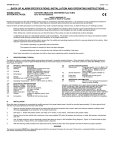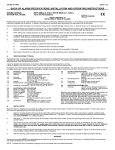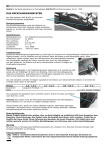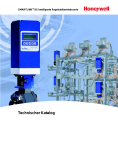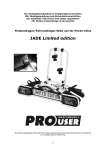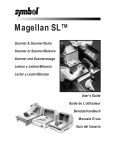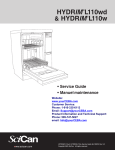Download back-up alarm specifications, installation and operating
Transcript
370-631-1C 06/2005 SAFETY MESSAGE TO OPERATORS OF BACK-UP ALARMS Sheet 1 of 2 BACK-UP ALARM SPECIFICATIONS, INSTALLATION AND OPERATING INSTRUCTIONS SOUND LEVEL: SYSTEM VOLTAGES: Should the alarm become inoperative, it could jeopardize the safety or lives of those who depend on the alarm signal for safety. 97 dB(A) SAE J994 MAR85 Type C 12 to 24 Volt Systems Testing the Back-Up Alarm should be listed on the daily maintenance report. The units on operating vehicles must be tested each day prior to the vehicle's operation. Results of this test must be recorded in the maintenance log. Notify your supervisor that people operating this equipment MUST check for proper operation at the beginning of every shift. SAFETY MESSAGE TO INSTALLERS OF BACK-UP ALARMS People's lives depend on the safe installation of this product in conformance with these instructions. It is necessary to read, understand and follow all instructions shipped with the product. In addition, listed below are important safety instructions and precautions you should follow. Failure to follow all safety precautions and instructions may result in property damage, serious injury, or death to those you are seeking to protect. Back-Up Alarms are intended for commercial use. Proper installation of a Back-Up Alarm requires a good understanding of truck and heavy equipment electrical systems and procedures, along with proficiency in the installation and use of safety warning equipment. C. MAINTENANCE Alarm should be inspected and the sound opening kept clear of dust, mud, or other foreign material that may obstruct the sound opening. D. FIGURE 1 - OUTLINE DRAWING AND WIRING DIAGRAM When drilling into a vehicle structure, be sure that both sides of the surface are clear of anything that could be damaged. Locate Back-Up Alarm so it will operate properly under all conditions. The location must provide protection from impact and adverse weather conditions while allowing unobstructed sound projection to the target hazard area. Inspect the Back-Up Alarm system daily to ensure that it is audible and operating properly and that it is securely attached to the vehicle. More frequent inspections should be performed when: The vehicle is operating in a particularly dirty environment. The operator has reason to suspect the alarm has been damaged. Increased background noise on the job site may interfere with the audibility of the alarm. Store these instructions in a safe place and refer to them when maintaining and/or reinstalling the product. A. SPECIFICATIONS (TYPICAL) The Back-Up Alarm is a solid state audible warning device enclosed in a weather resistant housing. When activated, the Back-Up Alarm produces a tone that is interrupted at a rate of approximately 80 times per minute with equal on and off times. This alarm conforms to SAE J994 MAR85, sound level Type C. 2.0 2.1 2.2 2.3 2.4 2.5 2.6 2.7 3.0 3.1 3.2 3.3 3.4 3.5 3.6 3.7 PHYSICAL SPECIFICATIONS Electronics: Solid state Sealing: Encapsulated to protect from dust, moisture and vibration. Housing: Black, 30% glass filled nylon Dimensions: 2.67"H x 4.02"W x 1.60"D (67.8mm x 102.1mm x 40.6mm) Weight: 10 oz (284 gm) Mounting: Two 0.328" (8.3mm) diameter holes on 3.25" (82.5mm) centers, both mounting plates o o o o Operating Temperature: -40 F to +165 F (-40 C to +74 C) 3.8 ELECTRICAL SPECIFICATIONS Minimum voltage: 9.8 volts DC Maximum voltage: 36.4 volts DC System voltages: 12 to 24 volt systems Input current: 0.2 amps average Fuse at: 2.0 amp Spike protection: +100, -400 volts Positive or negative ground, polarity Polarity: protected Connection: Two #8-32 UNC terminal studs B. INSTALLATION 4.0 4.1 4.2 4.3 4.4 5.0 5.1 OUTPUT SPECIFICATIONS Sound level: One level, 97 + 4 dB(A) at 4 feet with 28 VDC applied. Slightly lower on lower voltages. o Sound dispersion: Through 180 (graph available on request) Pulse rate: 80 pulses per minute typical 1200 Hz typical Frequency: ADDITIONAL INFORMATION Cleaning: Unit will not be damaged if exposed to steam or spray cleaning. High pressure systems not recommended. Selection and installation of an alarm should meet the requirements of SAE J1446 MAY 1989 "ON-MACHINE ALARM TEST AND EVALUATION PROCEDURE FOR CONSTRUCTION AND GENERAL PURPOSE INDUSTRIAL MACHINERY", and all applicable codes. Operation of the vehicle in noisy environments may require an alarm that is louder than indicated in SAE J1446 MAY 89. Install an alarm that will be audible on the noisiest job site on which the vehicle will be used. Ground guidance should be provided to clear backing vehicles when the audibility of the alarm is in question. Since this alarm is designed to concentrate its audible warning in the target hazard area it should be mounted approximately 4 ft. above ground level with the sound opening facing to the rear of the vehicle. 1. Select a mounting location at the rear of the vehicle that will provide protection from impact, debris and adverse weather conditions while allowing unobstructed sound projection to the target hazard area. The alarm's "L-type" mounting configuration provides mounting flexibility and allows installation in a variety of locations. 2. See figure 1. Using the alarm housing as a template, scribe drill position marks through the mounting holes in the unit. Drill holes at the position marks. 3. Secure the unit on the vehicle with a minimum of two user-supplied 5/16" bolts and locknuts, or bolts, lockwashers, and nuts. Optional attachment method; use one 5/16" dia. washer head bolt, hanging the alarm vertically and attaching the alarm through top hole. Optional configuration does not meet SAE J994 vibration requirements. Optional configuration does meet SAE J1455 for vibration in the vertical axis only. 4. Use 18 gage (minimum) wire to electrically connect the alarm as shown in the Simplified Wiring Diagram. Figure 1A if vehicle back-up light circuit is used, or Figure 1B if a user installed switch is required. 5. Affix the Warning Label provided to the dash board of the vehicle in plain view of the operator and test the alarm for proper operation. WARNING The ground connection MUST be a dependable ground path for as long as the device is to be used. Route wire in a protected fashion in accordance with vehicle manufacturer recommendations. NOTE: The Back-Up Alarm is sensitive to polarity and will not operate when connected backwards. 370-631-1C 06/2005 MANUFACTURER LIMITED WARRANTY AND LIMITATION OF LIABILITY Manufacturer warrants that on the Date of Purchase this Product will conform to Manufacturer's published specifications for the product, which are available from Manufacturer on request, and Manufacturer warrants that the product is free from defects in materials and workmanship. This Limited Warranty extends for twenty-four (24) months from the date of manufacture. Manufacturer will, at its option, repair or replace any product found by Manufacturer to be defective and subject to this Limited Warranty. This Limited Warranty does not apply to parts or products that are misused; abused; modified; damaged by accident, fire or other hazard; improperly installed or operated; or not maintained in accordance with the maintenance procedures set forth in Manufacturer's Installation and Operating Instructions. To obtain warranty service, you must ship the product(s) to the specified Manufacturer location within thirty (30) days from expiration of the warranty period. You must fill out the warranty claim form and include the form with the product. You must prepay shipping charges and use the original shipping container or equivalent. Return shipping charges within the United States, Canada, and Puerto Rico will be paid by Manufacturer. This Limited Warranty will apply only to a product purchased and located in the United States, Canada, or Puerto Rico. EXCLUSION OF OTHER WARRANTIES: MANUFACTURER MAKES NO OTHER WARRANTIES, EXPRESSED, IMPLIED OR STATUTORY. THE IMPLIED WARRANTIES FOR MERCHANTABILITY OR FITNESS FOR A PARTICULAR PURPOSE ARE HEREBY EXCLUDED AND SHALL NOT APPLY TO THE PRODUCT. BUYER'S SOLE AND EXCLUSIVE REMEDY IN CONTRACT, TORT OR UNDER ANY OTHER THEORY AGAINST MANUFACTURER RESPECTING THE PRODUCT AND ITS USE SHALL BE THE REPLACEMENT OR REPAIR OF THE PRODUCT AS DESCRIBED ABOVE. LIMITATION OF LIABILITY: IN THE EVENT OF LIABILITY FOR DAMAGES ARISING OUT OF THIS LIMITED WARRANTY OR ANY OTHER CLAIM RELATED TO MANUFACTURER'S PRODUCTS, MANUFACTURER'S LIABILITY FOR DAMAGES SHALL BE LIMITED TO THE AMOUNT PAID FOR THE PRODUCT AT THE TIME OF ORIGINAL PURCHASE. IN NO EVENT SHALL MANUFACTURER BE LIABLE FOR LOST PROFITS, THE COST OF SUBSTITUTE EQUIPMENT OR LABOR, PROPERTY DAMAGE, OR OTHER SPECIAL, CONSEQUENTIAL OR INCIDENTAL DAMAGES BASED UPON ANY CLAIM FOR BREACH OF CONTRACT, NEGLIGENCE OR OTHER CLAIM, EVEN IF MANUFACTURER OR A MANUFACTURER'S REPRESENTATIVE HAS BEEN ADVISED OF THE POSSIBILITY OF SUCH DAMAGES. Manufacturer shall have no further obligation or liability with respect to the product or its sale, operation and use, and Manufacturer neither assumes nor authorizes the assumption of any other obligation or liability in connection with such product. This Limited Warranty gives you specific legal rights, and you may also have other legal rights which vary from state to state. Some states do not allow the exclusion or limitation of incidental or consequential damages, so the above exclusion or limitation may not apply to you. Any oral statements or representations about the product which may have been made by salesmen or Manufacturer representatives do not constitute warranties. This Limited Warranty may not be amended, modified or enlarged, except by a written agreement signed by an authorized official of Manufacturer which expressly refers to this Limited Warranty. MESSAGE DE SÉCURITÉ AUX UTILISATEURS DES AVERTISSEURS SONORES DE RECUL Feuille 1 de 2 SPÉCIFICATIONS, INSTALLATION ET CONSIGNES D’UTILISATION DE L’AVERTISSEUR SONORE DE RECUL NIVEAU SONORE : TENSION DU SYSTÈME : 370-631-1C 06/2005 Sheet 2 of 2 Si l’avertisseur ne fonctionne plus, la sécurité ou la vie de ceux qui se fient à son signal sonore pourrait être mise en danger. 97 dB(A) SAE J994 MAR85 Type C Systèmes de 12 à 24 volts Les unités sur les véhicules utilisés doivent être testées chaque jour avant l’utilisation du véhicule. Les résultats de ce test doivent être inscrits dans le journal d’entretien quotidien. MESSAGE DE SÉCURITÉ AUX INSTALLATEURS D’AVERTISSEURS SONORES DE RECUL Conservez ces directives dans un endroit sûr et consultez-les lorsque vous entretenez et/ou réinstallez le produit. Ces consignes d’installation et d’utilisation d’avertisseurs sonores de recul énumérées ci-dessous doivent être lues attentivement et impérativement respectées. Le non respect de toutes les précautions et directives de sécurité pourrait entraîner des dommages matériels, des blessures graves ou le décès de ceux que vous tentez de protéger. Les avertisseurs sonores de recul sont conçus pour un usage commercial. Il faut une bonne compréhension du camion ainsi que des systèmes électriques de machinerie lourde et des procédures pour installer correctement l’avertisseur sonore de recul. Il faut aussi une maîtrise de l’installation et de l’utilisation de l’équipement d’avertissement de sécurité. Chaque utilisateur se servant de cet équipement DOIT en vérifier le bon fonctionnement au début de chaque journée de travail. Avertissez votre supérieur en cas de dysfonctionnement. C. ENTRETIEN L’avertisseur doit être inspecté et la membrane de sortie du son ne doit pas être obstruée par de la poussière, de la boue ou d’autres matières étrangères. D. FIGURE 1 – DESSIN GRAPHIQUE ET SCHÉMA DE CÂBLAGE Lorsque vous percez un trou dans la structure d’un véhicule, assurez-vous que rien ne peut être endommagé sur les deux côtés de la surface. Placez l’avertisseur sonore de recul de manière à ce qu’il fonctionne correctement dans toutes les conditions. L’emplacement doit offrir une protection contre les impacts et les intempéries tout en permettant une projection sonore sans obstacle dans la zone de danger visée. Inspectez le système d’avertisseur sonore de recul tous les jours pour vous assurer qu’il est audible, qu'il fonctionne correctement et qu’il est bien fixé au véhicule. Vous devriez faire des inspections plus fréquentes lorsque : Le véhicule fonctionne dans un environnement particulièrement salissant. Le conducteur a des raisons de croire que l’avertisseur a été endommagé. Une augmentation du bruit de fond sur les lieux de travail peut nuire à l’audibilité de l’avertisseur. Conservez ces directives dans un endroit sûr et consultez-les lorsque vous entretenez et/ou réinstallez le produit. A. SPÉCIFICATIONS (TYPIQUE) L’avertisseur sonore de recul est une alarme sonore à semi-conducteur abritée par un boîtier résistant aux intempéries. Lorsqu’il est activé, l’avertisseur sonore de recul produit un son à une fréquence de 80 fois par minute, avec des temps d’arrêt et de marche égaux. Cet avertisseur respecte la SAE J994 MAR85, niveau sonore de Type C. 2.0 2.1 2.2 2.3 2.4 2.5 2.6 2.7 3.0 3.1 3.2 3.3 3.4 3.5 3.6 3.7 3.8 SPÉCIFICATIONS PHYSIQUES Électronique : Semi-conducteur Étanchéification : En boîtier étanche pour le protéger de la poussière, de l’humidité et des vibrations. Boîtier : Noir, 30 % de nylon armé de verre Dimensions : 2,67"H x 4,02"L x 1,60"P (67,8 mm x 102,1 mm x 40,6 mm) Poids : 10 oz (284 g) Fixation : Deux trous de 0,328" (8,3 mm) de diamètre aux centres à 3,25" (82,5 mm), sur les deuxo plaques ode fixation o Température de fonctionnement : -40 F à +165 F (-40 C à o +74 C) SPÉCIFICATIONS ÉLECTRIQUES Tension minimale : 9,8 volts CC Tension maximale : 36,4 volts CC Tension du système : Systèmes de 12 à 24 volts Courant d’entrée : 0,2 ampères en moyenne Protégé par fusible à : 2,0 ampères (non fourni) Protection contre les variations brusques : +100, -400 volts Polarité : Avec dispositif de protection de mise à la masse pour polarité négative ou positive Connexion : Deux plots filetées, UNC #8-32 4.0 4.1 4.2 4.3 4.4 5.0 5.1 SPÉCIFICATIONS DE SORTIE Niveau sonore : Un niveau, 97 + 4 dB(A) à 4 pieds avec 28 c.c.v. Un peu plus faible à des tensions plus basses. o Dispersion acoustique : Sur 180 (graphique disponible sur demande) Taux d’impulsions : 80 impulsions par minute, habituellement Fréquence : 1200 Hz, habituellement INFORMATIONS SUPPLÉMENTAIRES Nettoyage : Le dispositif ne sera pas endommagé s’il est exposé à un nettoyage à la vapeur ou par pulvérisation. Les systèmes à pression élevée ne sont pas recommandés. Le choix et l’installation d’un avertisseur doit respecter les exigences de la SAE J1446 MAY 1989 « ON-MACHINE ALARM TEST AND EVALUATION PROCEDURE FOR CONSTRUCTION AND GENERAL PURPOSE INDUSTRIAL MACHINERY » ainsi que tous les codes qui s’appliquent. Si le véhicule est utilisé dans un environnement bruyant, il faudra peut-être un avertisseur plus puissant que celui indiqué dans la SAE J1446 MAY 89. Installez un avertisseur qui sera audible dans le lieu de travail le plus bruyant où le véhicule sera utilisé. Il devrait y avoir un guide pour les véhicules qui reculent lorsque l’audibilité de l’avertisseur est incertaine. B. INSTALLATION Comme l’avertisseur est conçu pour concentrer son avertissement sonore dans la zone de danger visée, il devrait être fixé à environ 1,2 mtr. au dessus du sol, l’ouverture pour le son tournée vers l'arrière du véhicule. 1. 2. 3. 4. 5. Choisissez un endroit à l’arrière du véhicule qui le protégera des impacts, des débris et des intempéries tout en permettant une projection acoustique sans obstacle dans la zone de danger visée. La fixation d’avertisseur de « type L » offre de la flexibilité pour le montage et permet l’installation à divers endroits. Voir la figure 1. À l’aide du boîtier de l’avertisseur comme modèle, tracez des repères de position pour la perceuse à travers les trous de montage de l’unité. Percez des trous sur les repères de position. Fixez l’unité sur le véhicule avec au moins deux boulons et contre-écrous de 5/16" fournis par l’utilisateur, ou encore avec des boulons, des rondelles d’arrêt et des écrous. Méthode de fixation optionnelle : utilisez l’un des boulons avec tête à embase de 5/16" de diamètre, suspendez l’avertisseur à la verticale et fixez-le par le trou supérieur. La configuration optionnelle ne respecte pas les exigences en matière de vibrations de la SAE J994. La configuration optionnelle respecte les exigences en matière de vibrations de la SAE J1455 pour l’axe vertical seulement. Utilisez un câble de calibre 18 (minimum) pour brancher l’avertisseur de la façon illustrée sur le schéma Câblage simplifié. Figure 1A si le circuit des feux de recul est utilisé ou Figure 1B si un interrupteur installé par l’utilisateur est nécessaire. Apposez sur le tableau de bord du véhicule l’étiquette d’avertissement fournie, bien en vue du conducteur, puis testez le bon fonctionnement de l’avertisseur. ATTENTION La connexion de mise à la masse DOIT suivre un circuit de mise à la masse fiable pour toute la durée d’utilisation de l’appareil. Acheminez le câble de façon à ce qu’il soit protégé, en respectant les recommandation de constructeur du véhicule. REMARQUE : L’avertisseur sonore de recul est sensible à la polarité et ne fonctionnera pas s’il est branché à l’envers. GARANTIE LIMITÉE DU FABRICANT ET LIMITATION DE RESPONSABILITÉ Le fabricant garantit que ce Produit respectera les spécifications de ce produit publiées par le Fabricant à la date d’achat. Ces spécifications sont disponibles sur demande auprès du Fabricant et le Fabricant garantit que le produit est exempt de vices de fabrication et de malfaçon. La présente garantie limitée vaut pour une durée de vingt-quatre (24) mois à partir de la date de fabrication. Le Fabricant devra, à sa discrétion, réparer ou remplacer le produit déclaré défectueux par le Fabricant et assujetti à cette Garantie limitée. Cette Garantie limitée ne s’applique pas aux pièces ni aux produits mal utilisés, utilisés de manière abusive, modifiés, endommagés par accident, par un incendie ou par tout autre risque. Elle ne s’applique pas non plus aux produits qui n’ont pas été installés ou utilisés correctement ou qui ne sont pas entretenus selon les procédures d’entretien indiquées dans le manuel d’installation et de consignes d’utilisation du Fabricant. Pour obtenir un service de garantie, vous devez expédier le(s) produit(s) à l'endroit spécifié par le Fabricant dans les trente (30) jours suivants l’expiration de la période de garantie. Le formulaire de réclamation au titre de la garantie dûment rempli doit accompagner le produit. Vous devez payer d’avance les frais d’expédition et utiliser l’emballage d’expédition d’origine ou un emballage équivalent. Les frais d’expédition pour le retour aux États-Unis, au Canada et à Porto Rico seront payés par le Fabricant. Cette Garantie limitée ne s’appliquera qu’à un produit acheté et situé aux ÉtatsUnis, au Canada ou à Porto Rico. EXCLUSION DES AUTRES GARANTIES : LE FABRICANT N’OFFRE AUCUNE AUTRE GARANTIE, EXPRESSE, IMPLICITE OU LÉGALE. LES GARANTIES IMPLICITES POUR LA QUALITÉ MARCHANDE OU LA CONVENANCE PRÉCISE SONT EXCLUSES PAR LA PRÉSENTE ET NE S’APPLIQUENT PAS AU PRODUIT. LE RECOURS UNIQUE ET EXCLUSIF DE L’ACHETEUR AU NIVEAU DU CONTRAT, DES PRÉJUDICES OU DE TOUTE AUTRE THÉORIE CONTRE LE FABRICANT CONCERNANT LE PRODUIT ET SON UTILISATION EST LE REMPLACEMENT OU LA RÉPARATION DU PRODUIT, TEL QUE DÉCRIT PLUS HAUT. LIMITATION DE RESPONSABILITÉ : EN CAS DE RESPONSABILITÉ POUR DES DOMMAGES SURVENANT DANS LE CADRE DE CETTE GARANTIE LIMITÉE OU DE TOUTE AUTRE RÉCLAMATION ASSOCIÉE AUX PRODUITS DU FABRICANT, LA RESPONSABILITÉ DU FABRICANT SE LIMITE AU MONTANT PAYÉ POUR LE PRODUIT AU MOMENT DE L’ACHAT INITIAL. EN AUCUN CAS LE FABRICANT NE PEUT ÊTRE TENU RESPONSABLE DES PERTES DE PROFIT, DES FRAIS DE REMPLACEMENT DE L’ÉQUIPEMENT OU DE MAIN D’OEUVRE, DES DOMMAGES MATÉRIELS, OU TOUT AUTRE DOMMAGE SPÉCIAL, CONSÉQUENT OU INCIDENT, EN RELATION AVEC TOUTE RÉCLAMATION EN VERTU D’UNE RUPTURE DE CONTRAT, DE NÉGLIGENCE OU DE TOUTE AUTRE RÉCLAMATION, ET CE MÊME SI LE FABRICANT OU LE REPRÉSENTANT DU FABRICANT A ÉTÉ AVERTI DE LA POSSIBILITÉ DE TELS DOMMAGES. Le Fabricant n'a aucune autre obligation ou responsabilité concernant le produit ou sa vente, son fonctionnement et son utilisation. De plus, le Fabricant n’assume ni n’autorise l’hypothèse d’une obligation ou d’une responsabilité en relation avec ce produit. La présente Garantie limitée vous accorde des droits légaux spécifiques et vous pourriez également avoir d’autres droits légaux, lesquels varient d’un état ou d’une province à l’autre. Certaines provinces ne permettent pas l’exclusion ou la limitation de pertes incidentes ou conséquentes. Dans ce cas, l’exclusion ou la limitation énoncée ci-dessus pourrait ne pas s’appliquer à vous. Aucune représentation ou affirmation verbale sur le produit pouvant avoir été faite par les vendeurs ou les représentants du Fabricant ne constitue une garantie. Cette Garantie limitée ne peut être amendée, modifiée ou élargie, sauf par une entente écrite et signée par un agent autorisé du Fabricant, et qui fait référence expressément à cette Garantie limitée. Feuille 2 de 2 370-631-1C 06/2005 370-631-1C 06/2005 SICHERHEITSHINWEISE FÜR DEN BEDIENER DES RÜCKFAHRWARNSYSTEMS Blatt 1 von 2 Sollte das Warnsystem ausfallen, kann dies die Sicherheit und das Leben derjenigen gefährden, die auf ein funktionierendes System angewiesen sind. BESCHREIBUNG, INSTALLATION UND BETRIEB DES RÜCKFAHRWARNSYSTEMS SCHALLPEGEL: SYSTEMSPANNUNG: Die Funktionsprüfung des Rückfahrwarnsystems sollte auf dem täglichen Wartungsbericht aufgeführt sein. Die an im Betrieb befindlichen Fahrzeugen angebrachten Geräte müssen täglich vor der Inbetriebnahme der Fahrzeuge überprüft werden. Die Ergebnisse dieser Überprüfung müssen im Wartungsbericht aufgeführt sein. 97 dB(A) SAE J994 MAR85 Typ C 12 V bis 24 V Weisen Sie Ihren Vorgesetzten darauf hin, dass Personen, die ein Fahrzeug mit diesem Gerät führen, die einwandfreie Funktion vor Beginn jeder Schicht überprüfen müssen. SICHERHEITSHINWEISE FÜR DEN EINBAU DES RÜCKFAHRWARNSYSTEMS Das Leben von Menschen hängt vom sachgerechten Einbau dieses Produkts unter Beachtung der Einbauvorschriften ab. Es ist notwendig, alle diesem Produkt beiliegenden Anweisungen zu lesen, zu verstehen und zu befolgen. Zusätzlich finden Sie nachfolgend wichtige Sicherheitshinweise und Vorsichtsmaßnahmen, die Sie beachten sollten. Das Nichtbefolgen dieser Sicherheitshinweise und Vorsichtsmaßnahmen kann zu Sachschäden bzw. zu schweren oder tödlichen Verletzungen von Personen führen, die geschützt werden sollen. Rückfahrwarnsysteme sind für den Einsatz in gewerblich genutzten Kraftfahrzeugen vorgesehen. Für den sachgerechten Einbau eines Rückfahrwarnsystems ist Sachkenntnis der elektrischen Systeme und der Betriebsbedingungen von Lkw und Nutzfahrzeugen sowie Erfahrung beim Einbau und der Bedienung von Sicherheitseinrichtungen erforderlich. C. WARTUNG Das Warnsystem sollte überprüft werden, und die Schallöffnung sollte von Staub, Schlamm oder anderen Materialien, die die Hörbarkeit des Warnsignals behindern könnte, freigehalten werden. D. ABBILDUNG 1 - ÜBERSICHTSZEICHNUNG UND SCHALTPLAN Stellen Sie sicher, dass bei Bohrungen in das Fahrzeuggehäuse keine innen oder außen angebrachten Vorrichtungen beschädigt werden. Bringen Sie das Rückfahrwarnsystem so an, dass es unter allen Bedingungen störungsfrei funktioniert. Der Einbauort muss so beschaffen sein, dass das Gerät vor äußeren Einflüssen wie Stößen, Schlägen oder Witterung geschützt ist und gleichzeitig eine ungehinderte Ausstrahlung des Warngeräuschs in den Gefahrenbereich möglich ist. Überprüfen Sie das Rückfahrwarnsystem täglich, um sicher zu stellen, dass das Signal hörbar ist und das System ordnungsgemäß funktioniert und sicher am Fahrzeug angebracht ist. Die Überprüfungen sollten in kürzeren Abständen stattfinden, wenn das Fahrzeug unter besonders schmutzintensiven Bedingungen betrieben wird. der Fahrzeugführer feststellt, dass das System beschädigt sein könnte. lauter Hintergrundlärm am Einsatzort die Hörbarkeit des Warnsignals beeinträchtigen könnte. Bewahren Sie diese Hinweise an einem sicheren Ort auf und lesen Sie sie, sobald Sie das Produkt warten und/oder wieder einbauen. A. SPEZIFIKATIONEN (TYPISCH) Das Rückfahrwarnsystem ist ein elektronisches Akustik-Warngerät in einem witterungsbeständigen Gehäuse. In aktiviertem Zustand erzeugt das Rückfahrwarnsystem einen Ton, der ca. 80-mal pro Minute unterbrochen wird, wobei die Dauer von Ton und Tonunterbrechung identisch ist. Dieses Warnsystem entspricht dem Schallpegeltyp C der SAE-Norm J994 MAR85. 2.0 2.1 2.2 2.3 2.4 2.5 2.6 2.7 3.0 3.1 3.2 3.3 3.4 3.5 3.6 3.7 3.8 PHYSIKALISCHE DATEN Elektronik: Halbleiter Abdichtung: Voll verkapselt zum Schutz vor Staub, Feuchtigkeit und Erschütterungen Gehäuse: Schwarz, 30 % glasgefülltes Nylon Abmessungen: 67,8 mm x 102,1 mm x 40,6 mm 284 g Gewicht: Befestigung: Zwei 8,3 mm-Bohrungen im Abstand von 82,5 mm, beide Montageplatten Betriebstemperatur: -40° C bis +74° C (-40° F bis +165° F) 4.0 4.1 4.2 4.3 4.4 5.0 5.1 ELEKTRISCHE DATEN Minimalspannung: 9,8 V Gleichspannung Maximalspannung: 36,4 V Gleichspannung Systemspannung: 12 V bis 24 V Stromaufnahme: 0,2 A (Ø) Sicherung: 2,0 A Spike-Schutz: +100 V, -400 V Polarität: Positive oder negative Erdung, polaritätsgeschützt Verbindung: Zwei UNC 8-32 Gewindebolzen AUSGANGSDATEN Schallpegel: Ein Pegel, 97 + 4 dB(A) auf ca. 1,20 m bei 28 V Gleichspannung. Etwas niedrigerer Pegel bei niedrigerer Spannung. Schallstreuung: 180° (Graph auf Anforderung erhältlich) Impulsrate: 80 Impulse/Minute (typisch) Frequenz: 1200 Hz typisch WEITERE INFORMATIONEN Reinigung: Das Gerät kann mit Dampf bzw. mit Sprays gereinigt werden, ohne dass Beschädigungen auftreten. Es wird empfohlen, keine Hochdruckreinigungsgeräte zu verwenden. Auswahl und Einbau eines Warnsystems müssen den Anforderungen der SAE J1446 MAY 1989 (ON-MACHINE ALARM TEST AND EVALUATION PROCEDURE FOR CONSTRUCTION AND GENERAL PURPOSE INDUSTRIAL MACHINERY") und allen anwendbaren Normen entsprechen. Der Fahrzeugbetrieb in lauten Umgebungen kann zur Folge haben, dass ein Warnsystem mit höherem Schallpegel als in der SAE J1446 MAY 89 angegeben benötigt wird. Verwenden Sie ein Warnsystem, das in der lautesten Umgebung, in der das Fahrzeug eingesetzt wird, noch hörbar ist. Sollte die Hörbarkeit des Warnsystems nicht unter allen Umständen gewährleistet sein, ist eine zusätzliche Person am Boden für die Fahrzeugeinweisung vorzusehen. B. EINBAU Da das Warnsignal vor allem im Gefahrenbereich hinter dem Fahrzeug hörbar sein muss, sollte das Gerät ca. 1,20 m über dem Boden angebracht werden. Die Schallöffnung sollte nach hinten gerichtet sein. 1. 2. 3. 4. 5. Wählen Sie den Einbauort an der Rückseite des Fahrzeugs so, dass das Gerät vor äußeren Einflüssen wie Stößen, Schlägen, Steinen oder Witterung geschützt ist und gleichzeitig eine ungehinderte Ausstrahlung des Warngeräuschs in den Gefahrenbereich möglich ist. Die Lförmige Einbaukonfiguration sorgt für Flexibilität, da dadurch eine Vielzahl von Einbauorten für die Montage in Frage kommt. Siehe Abbildung 1. Nutzen Sie das Gehäuse zum Markieren der Befestigungslöcher auf der Montageoberfläche. Bohren Sie die Befestigungslöcher an den markierten Positionen. Befestigen Sie das Gerät mit mindestens zwei 8 mm-Schrauben (nicht beiliegend) und Sicherungsmuttern bzw. Schrauben, Sicherungsscheiben und Muttern. Als Alternative kann eine Schraube mit 8 mm-Scheibe verwendet werden, um das Gehäuse senkrecht aufzuhängen und durch die obere Bohrung zu befestigen. Die Alternative entspricht nicht den Schwingungsanforderungen der SAE J994. Die Alternative entspricht den Schwingungsanforderungen der SAE J1455 nur für die senkrechte Achse. Verwenden Sie einen mindestens 1 mm starken Draht, um die elektrische Verbindung laut dem vereinfachten Schaltplan herzustellen. Abbildung 1A bei Verwendung des Rückfahr-Schaltkreises des Fahrzeugs oder Abbildung 1B bei Verwendung eines kundenseitigen Schalters. Bringen Sie den beigelegten Warnaufkleber für den Fahrzeugführer gut sichtbar an der Instrumententafel an, und überprüfen Sie die korrekte Funktion des Warnsystems. GEWÄHRLEISTUNG UND HAFTUNGSBESCHRÄNKUNG Der Hersteller garantiert, dass dieses Produkt zum Zeitpunkt des Kaufdatums allen vom Hersteller für dieses Produkt veröffentlichten technischen Daten (auf Anfrage vom Hersteller erhältlich) entspricht und frei von Herstellungs- und Materialfehlern ist. Diese Garantie gilt für einen Zeitraum von vierundzwanzig (24) Monaten ab Herstellungsdatum. Der Hersteller wird im Rahmen dieser Garantie alle vom Hersteller als fehlerhaft eingestuften Produkte nach eigenem Ermessen reparieren oder ersetzen. Diese Garantie gilt nicht für Teile oder Produkte, die falsch verwendet, missbraucht, verändert, durch Unfall, Feuer oder eine andere Gefahrenquelle beschädigt, falsch installiert oder betrieben bzw. nicht gemäß der Installations- und Bedienungsanleitung vom Hersteller gewartet wurden. Um eine Garantieleistung zu erhalten, müssen Sie das (die) Produkt(e) innerhalb von 30 Tagen nach Ablauf der Garantiezeit an die angegebene Herstelleradresse schicken. Die Garantiekarte muss ausgefüllt sein und dem Produkt beiliegen. Die Versandkosten müssen von Ihnen bezahlt werden, und es muss die Original-Versandverpackung oder eine gleichwertige Verpackung verwendet werden. Die Versandkosten für den Rücktransport innerhalb der Vereinigten Staaten von Amerika, Kanadas und Puerto Ricos übernimmt der Hersteller. Diese beschränkte Haftung erstreckt sich nur auf Produkte, die in den Vereinigten Staaten von Amerika, Kanada und Puerto Rico gekauft wurden und betrieben werden. AUSSCHLUSS WEITERER GARANTIEANSPRÜCHE: DER HERSTELLER ÜBERNIMMT KEINE WEITEREN GARANTIEN JEGLICHER ART (AUSDRÜCKLICH, IMPLIZIERT ODER GESETZLICH). KONKLUDENTE GEWÄHRLEISTUNGEN DER HANDELSÜBLICHKEIT ODER EIGNUNG FÜR EINEN BESTIMMTEN ZWECK WERDEN HIERMIT AUSDRÜCKLICH AUSGESCHLOSSEN UND GELTEN NICHT FÜR DIESES PRODUKT. DIE EINZIGEN UND ALLEINIGEN VERTRAGLICHEN ANSPRÜCHE DES KÄUFERS IN BEZUG AUF DAS PRODUKT UND SEINE VERWENDUNG SIND, WIE OBEN BESCHRIEBEN, ENTWEDER DER AUSTAUSCH ODER DIE REPARATUR DES PRODUKTS. HAFTUNGSBESCHRÄNKUNG: BEI HAFTUNG FÜR SCHÄDEN, DIE IM RAHMEN DIESER GARANTIE ENTSTANDEN SIND, ODER BEI ANDEREN ANSPRÜCHEN IN BEZUG AUF PRODUKTE DES HERSTELLERS IST DIE HERSTELLERHAFTUNG FÜR SCHÄDEN AUF DEN KAUFPREIS FÜR DAS PRODUKT ZUM URSPRÜNGLICHEN KAUFZEITPUNKT BESCHRÄNKT. DER HERSTELLER HAFTET UNTER KEINEN UMSTÄNDEN FÜR ENTGANGENEN GEWINN, KOSTEN FÜR ERSATZGERÄTE ODER ARBEITSZEIT, SACHSCHÄDEN ODER ANDERE BESONDERE, ZUFÄLLIGE ODER FOLGESCHÄDEN, DIE AUS EINEM SCHADENERSATZANSPRUCH WEGEN VERTRAGSBRUCH, FAHRLÄSSIGKEIT ODER ANDEREN ANSPRÜCHEN HERGELEITET WERDEN, SELBST WENN DER HERSTELLER ODER SEIN VERTRETER VON DER MÖGLICHKEIT SOLCHER SCHÄDEN UNTERRICHTET WAR. Der Hersteller übernimmt keine weitere Verpflichtung oder Haftung für das Produkt, dessen Verkauf, Betrieb oder Verwendung, noch übernimmt oder genehmigt der Hersteller eine Übernahme einer weiteren Verpflichtung oder Haftung in Verbindung mit einem solchen Produkt. Diese Garantie gibt Ihnen bestimmte Rechte zusätzlich zu anderen Rechten, die je nach Land verschieden sein können. In einigen Staaten ist der Ausschluss bzw. die Beschränkung von zufälligen oder Folgeschäden nicht gestattet, sodass die oben aufgeführten Ausschlüsse u. U. nicht auf Sie zutreffen. Mündliche Absprachen oder Aussagen zu dem Produkt durch Verkäufer oder Vertreter des Herstellers sind keine zugesicherten Eigenschaften. Eine Änderung bzw. Erweiterung dieser Garantie darf nur durch eine schriftliche Erklärung erfolgen, die von einem autorisierten Vertreter des Herstellers unterschrieben ist und sich ausdrücklich auf diese Garantie bezieht. ACHTUNG 370-631-1C 06/2005 Blatt 2 von 2 Die Masseverbindung MUSS für die Dauer der Benutzung des Gerätes zuverlässig funktionieren. Verlegen Sie das Kabel geschützt und in Übereinstimmung mit den Empfehlungen des Fahrzeugherstellers. HINWEIS: Das Rückfahrwarnsystem ist polaritätssensitiv und kann bei umgekehrter Verbindungsrichtung nicht betrieben werden. 370-631-1C 06/2005 MENSAJE DE SEGURIDAD PARA LOS OPERADORES DE ALARMAS DE RESPALDO Hoja 1 de 2 En caso de que la alarma deje de funcionar, se podría poner en riesgo la seguridad o la vida de aquellas personas cuya seguridad depende de la señal de alarma. ESPECIFICACIONES DE LA ALARMA DE MARCHA ATRAS, INSTALACIÓN E INSTRUCCIONES DE OPERACIÓN NIVEL DE SONIDO: TENSIONES DEL SISTEMA: El informe de mantenimiento diario debe incluir una prueba de la alarma de marcha atras. Las unidades que se encuentran en vehículos en operación deben probarse diariamente antes de operar el vehículo. Los resultados de dicha prueba deben anotarse en el registro de mantenimiento. 97 dB(A) SAE J994 MAR85 tipo C Sistemas de 12 a 24 voltios Notifique a su supervisor que el personal que opera este equipo DEBE comprobar la operación correcta al inicio de cada turno. MENSAJE DE SEGURIDAD PARA LOS INSTALADORES DE ALARMAS DE MARCHA ATRAS C. MANTENIMIENTO La vida de las personas depende de la instalación segura de este producto conforme a estas instrucciones. Es necesario que lea, entienda y siga todas las instrucciones enviadas con el producto. Además, a continuación encontrará instrucciones y precauciones de seguridad importantes que debe seguir. La alarma debe inspeccionarse y la abertura de sonido debe mantenerse libre de polvo, lodo o material extraño que pudiera obstruir dicha abertura. La omisión de las instrucciones y las precauciones de seguridad pueden dar como resultado daños materiales, lesiones graves o la muerte de aquellas personas a quienes pretende proteger. D. FIGURA 1 – DIBUJO ESQUEMÁTICO Y DIAGRAMA DE CABLEADO Las alarmas de respaldo son para uso comercial. La instalación correcta de una alarma de marcha atras requiere que comprenda bien los procedimientos y los sistemas eléctricos de equipos pesados y de camiones, y también requiere la competencia en la instalación y el uso de equipos de advertencia de seguridad. Al perforar la estructura de un vehículo, asegúrese de que ambos lados de la superficie estén libres de cualquier objeto que pueda dañarse. Coloque la alarma de marcha atras de manera que funcione correctamente en todas las condiciones. La ubicación debe brindar protección contra impactos y condiciones climáticas adversas, a la vez que permite la proyección del sonido sin obstrucciones hacia el área objetivo de riesgo. Inspeccione diariamente el sistema de la alarma de marcha atras para asegurarse de que sea audible y de que funcione correctamente y esté colocada firmemente en el vehículo. Debe realizar inspecciones más frecuentes en las siguientes circunstancias: Cuando el vehículo opere en un entorno especialmente sucio. Cuando el operador tenga razones para sospechar que la alarma se ha dañado. Cuando exista la posibilidad de que el mayor ruido de fondo en el lugar de trabajo interfiera con la audibilidad de la alarma. Guarde estas instrucciones en un lugar seguro y consúltelas cuando realice tareas de mantenimiento o reinstale el producto. A. ESPECIFICACIONES (TÍPICAS) La alarma de marcha atras es un dispositivo de advertencia audible de estado sólido dentro de un compartimiento resistente a la intemperie. Al activarse, la alarma de marcha atras emite un tono que se interrumpe a una velocidad de aproximadamente 80 veces por minuto con tiempos equivalentes de encendido y apagado. Esta alarma cumple con los requisitos de SAE J994 MAR85, nivel de sonido tipo C. 2.0 2.1 2.2 2.3 2.4 2.5 2.6 2.7 3.0 3.1 3.2 3.3 3.4 3.5 3.6 3.7 ESPECIFICACIONES FÍSICAS Circuitos electrónicos: Estado sólido Sellado: encapsulada para protección contra el polvo, la humedad y la vibración. Compartimiento: Negro, nylon relleno de vidrio al 30% Dimensiones: 2.67 pulg. alto x 4.02 pulg. ancho x 1.60 pulg. fondo (67.8 mm x 102.1 mm x 40.6 mm) Peso: 10 onzas (284 gr) Montaje: Dos orificios de 0.328 pulg. (8.3 mm) de diámetro en centros de 3.25 pulg. (82.5 mm), ambas placas de montaje Temperatura de operación: -40 oF a +165 oF (-40 oC a +74 oC) 3.8 ESPECIFICACIONES ELÉCTRICAS Tensión mínima: 9.8 voltios CC Tensión máxima: 36.4 voltios CC Tensiones del sistema:sistemas de 12 a 24 voltios Corriente de entrada: promedio de 0.2 amp Fusible en: 2.0 amp Protección contra picos: +100, -400 voltios Polaridad: Tierra positiva o negativa, protección de polaridad. Conexión: Dos terminales UNC núm. 8-32. B. INSTALACIÓN 4.0 4.1 4.2 4.3 4.4 5.0 5.1 ESPECIFICACIONES DE SALIDA Nivel de sonido: Un nivel, 97 + 4 dB(A) a 4 pies cuando se aplican 28 Vcc. Ligeramente inferior con tensiones inferiores. Dispersión de sonido: hasta 180° (gráfica disponible a solicitud). Velocidad de impulso: 80 impulsos por minuto, típica. Frecuencia: 1200 Hz, típica. INFORMACIÓN ADICIONAL Limpieza: La unidad no se verá dañada si se le expone a limpieza con vapor o por rociado. No se recomienda utilizar sistemas de alta presión. La selección y la instalación de una alarma debe cumplir con los requisitos de SAE J1446 MAYO DE 1989 “PRUEBA DE ALARMA EN LA MÁQUINA Y PROCEDIMIENTOS DE EVALUACIÓN PARA MAQUINARIA INDUSTRIAL MULTIUSO Y PARA LA CONSTRUCCIÓN”, así como con todos los códigos correspondientes. Es posible que la operación del vehículo en entornos ruidosos requiera una alarma que suene más fuerte que lo indicado en los requisitos de SAE J1446 MAYO DE 1989. Instale una alarma que sea audible en el lugar de trabajo más ruidoso en el que se utilizará el vehículo. Debe proporcionarse la guía para conexión a tierra para despejar los vehículos en reversa cuando la audibilidad de la alarma esté en duda. Ya que la alarma está diseñada para concentrar su advertencia audible en el área objetivo de riesgo, debe montarse aproximadamente 4 pies (1.2 m) por arriba del nivel del suelo con la abertura de sonido de frente a la parte posterior del vehículo. 1. Seleccione una ubicación de montaje en la parte posterior del vehículo que dará protección contra impactos, escombros y condiciones climáticas adversas, a la vez que permite la proyección del sonido sin obstrucciones hacia el área objetivo de riesgo. La configuración de montaje “tipo L” de la alarma ofrece flexibilidad de montaje y permite la instalación en diferentes ubicaciones. 2. Consulte la figura 1. Utilice el compartimiento de la alarma como una plantilla para trazar las marcas de posición de perforación a través de los orificios de montaje en la unidad. Perfore los orificios en las marcas de posición. 3. Fije la unidad en el vehículo con un mínimo de dos pernos y contratuercas estrelladas de 5/16 pulg., o pernos, arandelas de retención y tuercas proporcionadas por el usuario. Método opcional de unión: utilice un perno de con arandela de 5/16 pulg. de diámetro, con la alarma colgando verticalmente y uniendo la alarma a través del orificio superior. La configuración opcional no cumple con los requisitos de vibración de SAE J994. La configuración opcional sí cumple con los requisitos de SAE J1455 para vibración únicamente en el eje vertical. 4. Utilice cable de calibre 18 (mínimo) para conectar eléctricamente la alarma como se muestra en el Diagrama de cableado simplificado. La Figura 1A si se utiliza el circuito de luz de respaldo o la Figura 1B si se requiere un interruptor instalado por el usuario. 5. Fije la etiqueta de advertencia que se proporciona para el tablero de instrumentos del vehículo a la vista del operador y pruebe que la alarma funcione correctamente. ADVERTENCIA La conexión a tierra DEBE ser un trayecto confiable de conexión a tierra por todo el tiempo que se utilice el dispositivo. Tienda el cable en forma protegida conforme a las recomendaciones del fabricante del vehículo. NOTA: la alarma de marcha atras es sensible a la polaridad y no funcionará si se conecta al revés. GARANTÍA LIMITADA Y LÍMITES DE RESPONSABILIDAD DEL FABRICANTE El fabricante garantiza que en la fecha de compra, este producto cumple con las especificaciones publicadas por el fabricante para el producto, que se pueden conseguir solicitándolas al fabricante. El fabricante garantiza además que el producto está libre de defectos tanto en los materiales como en la mano de obra. Esta Garantía Limitada se extiende por un período de veinticuatro (24) meses a partir de la fecha de fabricación. El fabricante reparará o reemplazará, a su criterio, cualquier producto que considere defectuoso y que esté sujeto a los términos de la presente Garantía Limitada. Esta Garantía Limitada no se aplica a las piezas o los productos que se hayan sometido a uso indebido, abuso, modificaciones, daños accidentales o debidos a incendio u otras condiciones peligrosas, instalación u operación inadecuada o trabajos de mantenimiento no realizados de acuerdo a los procedimientos de mantenimiento que se describen en las Instrucciones de instalación y operación del fabricante. Para obtener servicio de garantía, debe enviar el o los productos a la localidad especificada del fabricante dentro de un plazo de treinta (30) días a partir del vencimiento del período de garantía. Debe llenar el formulario de reclamo de garantía e incluir dicho formulario con el producto. Debe pagar por adelantado los cargos de envío y utilizar el contenedor de transporte original o uno equivalente. El fabricante pagará los cargos de envío por devolución dentro de los Estados Unidos, Canadá y Puerto Rico. Esta Garantía Limitada se aplicará solamente a un producto adquirido y ubicado en los Estados Unidos, Canadá o Puerto Rico. EXCLUSIÓN DE OTRAS GARANTÍAS: EL FABRICANTE NO EXTIENDE NINGUNA OTRA GARANTÍA, YA SEA EXPLÍCITA, IMPLÍCITA O PREVISTA POR LA LEY. POR LA PRESENTE SE EXCLUYEN LAS GARANTÍAS IMPLÍCITAS DE COMERCIABILIDAD O IDONEIDAD PARA UN FIN EN PARTICULAR Y, POR LO TANTO, DICHAS GARANTÍAS NO SE APLICARÁN AL PRODUCTO. EN CASO DE UNA DEMANDA PRESENTADA CONTRA EL FABRICANTE POR INCUMPLIMIENTO DE CONTRATO, RESPONSABILIDAD CIVIL EXTRACONTRACTUAL O POR CUALQUIER OTRA TEORÍA DE RESPONSABILIDAD LEGAL CON RESPECTO AL PRODUCTO Y SU USO, EL RECURSO ÚNICO Y EXCLUSIVO DEL COMPRADOR SERÁ EL REEMPLAZO O LA REPARACIÓN DE TAL PRODUCTO EN LA FORMA ANTES DESCRITA. LIMITACIÓN DE RESPONSABILIDAD: EN CASO DE QUE SURJA ALGUNA RESPONSABILIDAD POR DAÑOS Y PERJUICIOS BAJO LOS TÉRMINOS DE LA PRESENTE GARANTÍA LIMITADA, O DE CUALQUIER OTRA DEMANDA RELACIONADA CON LOS PRODUCTOS DEL FABRICANTE, LA RESPONSABILIDAD DEL FABRICANTE POR DAÑOS Y PERJUICIOS SE LIMITARÁ AL IMPORTE PAGADO POR EL PRODUCTO EN EL MOMENTO DE ADQUIRIRLO ORIGINALMENTE. EL FABRICANTE NO SE HARÁ RESPONSABLE BAJO NINGUNA CIRCUNSTANCIA DE LAS GANANCIAS NO REALIZADAS, LOS COSTOS EN QUE SE INCURRA PARA SUSTITUIR EL EQUIPO O LOS GASTOS DE MANO DE OBRA, NI DE LOS DAÑOS A LA PROPIEDAD, NI TAMPOCO DE OTROS DAÑOS ESPECIALES, CONSIGUIENTES O INCIDENTALES BASADOS EN CUALQUIER DEMANDA POR INCUMPLIMIENTO DE CONTRATO, NEGLIGENCIA U OTRAS DEMANDAS, INCLUSO SI SE HUBIERE NOTIFICADO AL FABRICANTE O A UN REPRESENTANTE DEL FABRICANTE DE LA POSIBILIDAD DE TALES DAÑOS. El fabricante no tendrá ninguna otra obligación o responsabilidad con relación al producto o su venta, operación y uso, y el fabricante no asume ni autoriza a nadie a asumir ninguna otra obligación o responsabilidad con relación a dicho producto. Esta Garantía Limitada le otorga derechos legales específicos, y es posible que usted tenga otros derechos legales que pueden variar de una jurisdicción a otra. En algunas jurisdicciones no está permitido excluir o limitar los daños incidentales o consiguientes, de modo que es posible que la exclusión o limitación anterior no corresponda en su caso. Las declaraciones o representaciones verbales acerca del producto que pueda haber hecho un vendedor o representante del fabricante no constituyen una garantía. La presente Garantía Limitada no podrá alterarse, modificarse ni ampliarse, salvo por medio de un acuerdo por escrito firmado por un funcionario autorizado del fabricante que incluya una referencia explícita a esta Garantía Limitada. Hoja 2 de 2 370-631-1C 06/2005


